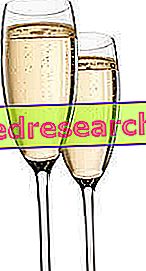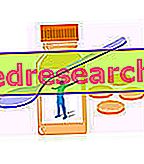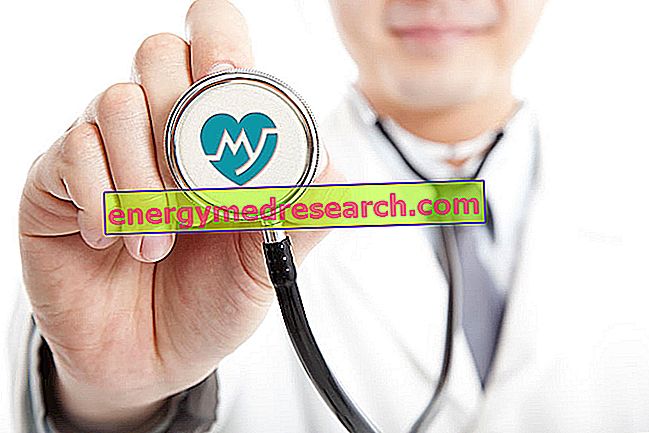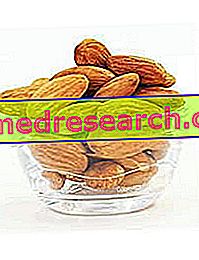What is Spumante
Sparkling wine is an effervescent wine characterized by the presence of carbon dioxide, contained in higher quantities than common "sparkling" wines. Quality sparkling wines are obtained by totally natural fermentation, but there are added ones in carbonic acid; these will not be treated in the article.

Compared to other wines (including sparkling wines), sparkling wines boast absolutely unique characteristics: high concentration of carbon dioxide (between 3 and 3.5 bar and over, depending on the quality), modest alcoholic strength and peculiar organoleptic and taste characteristics (induced by numerous variables: grapes of origin, various fermentations, fermentation and maturation).
NB . Among the highest quality sparkling wines, often the pressure (estimated at 20 ° C) reaches 5-6 bar.
Nutritional Composition
Sparkling wine is an alcoholic beverage. It boasts an alcohol content of about 15.3% Vol. (12.1g), therefore it is NOT a super-alcoholic. This clarification is fundamental, since the consumption portion of both categories is quite different.
The sparkling wine examined in the table is probably of the Charmat type with a long permanence on the yeasts, since it contains very few simple sugars (higher in Charmat Spumanti without or for a short time) and a non-excessive alcohol percentage (higher in the Champenoise method).
| Composition for: 100g of Sparkling Wine | |||||||||||||||||||||||||||||||||||||||||||||||||||||||||||||||||||||||||||||||||||||||||||||||||||||||||||||||||||||||||||||||||||||||||||||||||
 | |||||||||||||||||||||||||||||||||||||||||||||||||||||||||||||||||||||||||||||||||||||||||||||||||||||||||||||||||||||||||||||||||||||||||||||||||
Nutritional values (per 100 g of edible portion)
| |||||||||||||||||||||||||||||||||||||||||||||||||||||||||||||||||||||||||||||||||||||||||||||||||||||||||||||||||||||||||||||||||||||||||||||||||
In the sparkling wine there are no noteworthy nutritional supplies, therefore it is an "empty" drink; moreover, compared to red wines, white sparkling wines do NOT contain the same amount of antioxidant phenolic substances (they are much lower!), an aspect that makes them completely useless in human nutrition.
Diet and Health
Sparkling Wine in the Diet and Healthy Aspects
The average portion of sparkling wine is about one or two glasses of 125ml / day, but this recommendation makes the age, health and special conditions of the subject dependent.
The consumption of sparkling wine (and of all alcoholic beverages) is completely discouraged in the case of metabolic pathologies (especially hypertension, hypertriglyceridemia and overt metabolic syndrome), renal, hepatic and pancreatic suffering; furthermore, we recall that ethyl alcohol is toxic to tissues and harmful to the mucous membranes of the digestive tract, predisposes to gastric hyperacidity and promotes the onset of gastro esophageal reflux, gastritis and ulcer (both gastric and duodenal); keep in mind that a chronic and neglected gastro esophageal reflux can promote the mutation in Barrett's esophagus and increase the risk of cancer.
Less serious, but still noteworthy, the potential of alcohol to irritate the intestinal mucosa and the tendency to favor the onset of irritable bowel. For this reason, alcoholic beverages are also contraindicated in case of Crohn's disease and Rectum-Colitis-Ulcerative.
The sparkling wine does not lend itself to the nutrition of the pregnant woman, of the nurse, of the elderly person suffering from intestinal malabsorption and of the sportsman who, due to the action of ethyl alcohol, may undergo dehydration of the body. Furthermore, let us not forget that alcoholic beverages can significantly alter the balance of sleep.
It is also necessary to specify that the sparkling wine, although not too alcoholic, interferes with the metabolism of the drugs and that, if it is the object of abuse, it helps to form or consolidate the toxic addiction to ethyl alcohol.
Spumante - Regulations, Categories, Vines and Methods »



